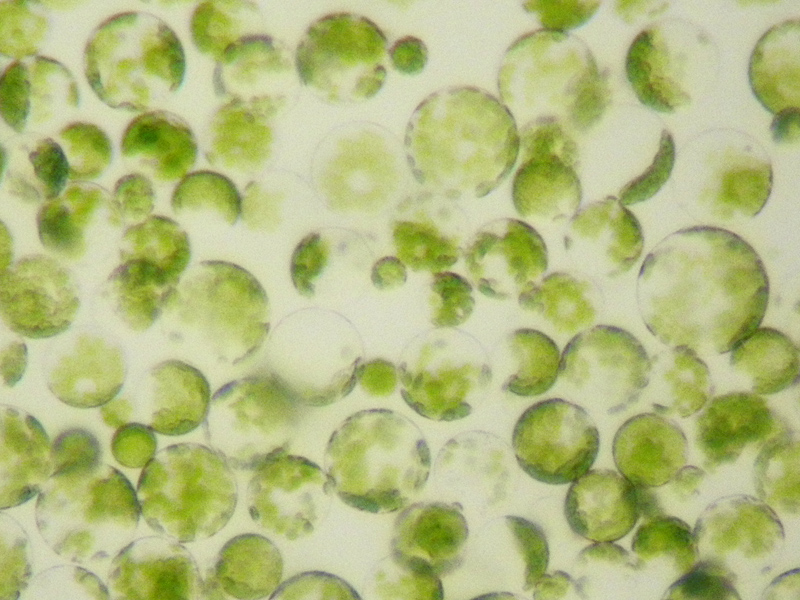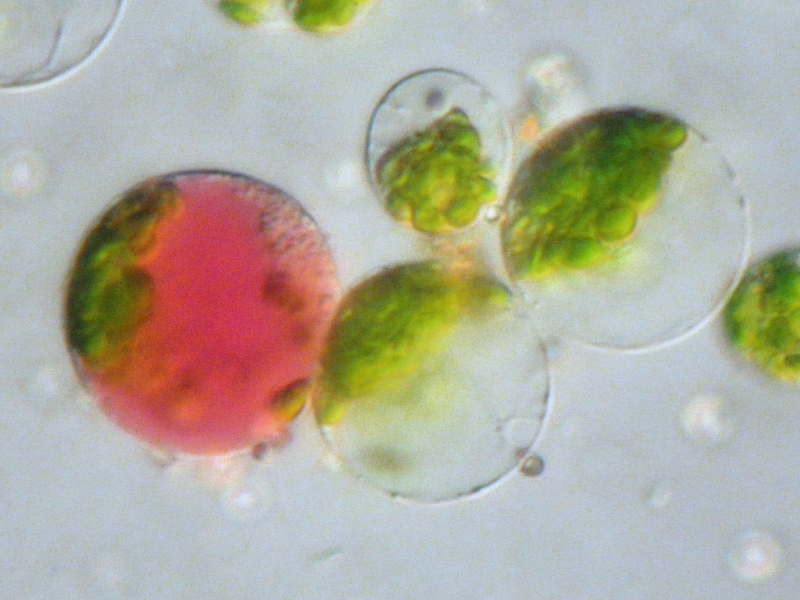protoplasts on:
[Wikipedia]
[Google]
[Amazon]

 Protoplast (), is a
Protoplast (), is a
 Protoplasts can be used to study
Protoplasts can be used to study

 Protoplast (), is a
Protoplast (), is a biological
Biology is the scientific study of life and living organisms. It is a broad natural science that encompasses a wide range of fields and unifying principles that explain the structure, function, growth, origin, evolution, and distribution of ...
term coined by Hanstein in 1880 to refer to the entire cell, excluding the cell wall. Protoplasts can be generated by stripping the cell wall
A cell wall is a structural layer that surrounds some Cell type, cell types, found immediately outside the cell membrane. It can be tough, flexible, and sometimes rigid. Primarily, it provides the cell with structural support, shape, protection, ...
from plant
Plants are the eukaryotes that form the Kingdom (biology), kingdom Plantae; they are predominantly Photosynthesis, photosynthetic. This means that they obtain their energy from sunlight, using chloroplasts derived from endosymbiosis with c ...
, bacterial
Bacteria (; : bacterium) are ubiquitous, mostly free-living organisms often consisting of one biological cell. They constitute a large domain of prokaryotic microorganisms. Typically a few micrometres in length, bacteria were among the ...
, or fungal
A fungus (: fungi , , , or ; or funguses) is any member of the group of eukaryotic organisms that includes microorganisms such as yeasts and molds, as well as the more familiar mushrooms. These organisms are classified as one of the tradit ...
cells by mechanical, chemical or enzymatic means.
Protoplasts differ from spheroplasts in that their cell wall has been completely removed. Spheroplasts retain part of their cell wall. In the case of Gram-negative bacteria
Gram-negative bacteria are bacteria that, unlike gram-positive bacteria, do not retain the Crystal violet, crystal violet stain used in the Gram staining method of bacterial differentiation. Their defining characteristic is that their cell envelo ...
l spheroplasts, for example, the peptidoglycan
Peptidoglycan or murein is a unique large macromolecule, a polysaccharide, consisting of sugars and amino acids that forms a mesh-like layer (sacculus) that surrounds the bacterial cytoplasmic membrane. The sugar component consists of alternating ...
component of the cell wall has been removed but the outer membrane component has not.
Enzymes for the preparation of protoplasts
Cell walls are made of a variety ofpolysaccharide
Polysaccharides (), or polycarbohydrates, are the most abundant carbohydrates found in food. They are long-chain polymeric carbohydrates composed of monosaccharide units bound together by glycosidic linkages. This carbohydrate can react with wat ...
s. Protoplasts can be made by degrading cell walls with a mixture of the appropriate polysaccharide-degrading enzyme
An enzyme () is a protein that acts as a biological catalyst by accelerating chemical reactions. The molecules upon which enzymes may act are called substrate (chemistry), substrates, and the enzyme converts the substrates into different mol ...
s:
During and subsequent to digestion of the cell wall, the protoplast becomes very sensitive to osmotic
Osmosis (, ) is the spontaneous net movement or diffusion of solvent molecules through a selectively-permeable membrane from a region of high water potential (region of lower solute concentration) to a region of low water potential (region o ...
stress. This means cell wall digestion and protoplast storage must be done in an isotonic solution to prevent rupture of the plasma membrane
The cell membrane (also known as the plasma membrane or cytoplasmic membrane, and historically referred to as the plasmalemma) is a biological membrane that separates and protects the interior of a cell from the outside environment (the extr ...
.
Uses for protoplasts
 Protoplasts can be used to study
Protoplasts can be used to study membrane
A membrane is a selective barrier; it allows some things to pass through but stops others. Such things may be molecules, ions, or other small particles. Membranes can be generally classified into synthetic membranes and biological membranes. Bi ...
biology, including the uptake of macromolecule
A macromolecule is a "molecule of high relative molecular mass, the structure of which essentially comprises the multiple repetition of units derived, actually or conceptually, from molecules of low relative molecular mass." Polymers are physi ...
s and virus
A virus is a submicroscopic infectious agent that replicates only inside the living Cell (biology), cells of an organism. Viruses infect all life forms, from animals and plants to microorganisms, including bacteria and archaea. Viruses are ...
es . These are also used in somaclonal variation.
Protoplasts are widely used for DNA
Deoxyribonucleic acid (; DNA) is a polymer composed of two polynucleotide chains that coil around each other to form a double helix. The polymer carries genetic instructions for the development, functioning, growth and reproduction of al ...
transformation (for making genetically modified organism
A genetically modified organism (GMO) is any organism whose genetic material has been altered using genetic engineering techniques. The exact definition of a genetically modified organism and what constitutes genetic engineering varies, with ...
s), since the cell wall would otherwise block the passage of DNA into the cell. In the case of plant cells, protoplasts may be regenerated into whole plants first by growing into a group of plant cells that develops into a callus
A callus (: calluses) is an area of thickened and sometimes hardened skin that forms as a response to repeated friction, pressure, or other irritation. Since repeated contact is required, calluses are most often found on the feet and hands, b ...
and then by regeneration of shoots ( caulogenesis) from the callus using plant tissue culture
Plant tissue culture is a collection of techniques used to maintain or grow plant cells, tissues, or organs under sterile conditions on a nutrient culture medium of known composition. It is widely used to produce clones of a plant in a method know ...
methods. Growth of protoplasts into callus and regeneration of shoots requires the proper balance of plant growth regulators in the tissue culture medium that must be customized for each species of plant. Unlike protoplasts from vascular plant
Vascular plants (), also called tracheophytes (, ) or collectively tracheophyta (; ), are plants that have lignin, lignified tissues (the xylem) for conducting water and minerals throughout the plant. They also have a specialized non-lignified Ti ...
s, protoplasts from moss
Mosses are small, non-vascular plant, non-vascular flowerless plants in the taxonomic phylum, division Bryophyta (, ) ''sensu stricto''. Bryophyta (''sensu lato'', Wilhelm Philippe Schimper, Schimp. 1879) may also refer to the parent group bryo ...
es, such as ''Physcomitrella patens
''Physcomitrella patens'' is a synonym of ''Physcomitrium patens'', the spreading earthmoss. It is a moss, a bryophyte used as a model organism for studies on plant evolution, development, and physiology.
Distribution and ecology
''Physcomitr ...
'', do not need phytohormone
Plant hormones (or phytohormones) are signal molecules, produced within plants, that occur in extremely low concentrations. Plant hormones control all aspects of plant growth and development, including embryogenesis, the regulation of organ si ...
s for regeneration, nor do they form a callus during regeneration. Instead, they regenerate directly into the filamentous protonema, mimicking a germinating moss spore.
Protoplasts may also be used for plant breeding
Plant breeding is the science of changing the traits of plants in order to produce desired characteristics. It is used to improve the quality of plant products for use by humans and animals. The goals of plant breeding are to produce crop varie ...
, using a technique called protoplast fusion
Somatic fusion, also called protoplast fusion, is a type of genetic modification in plants by which two distinct species of plants are fused together to form a new Hybrid (biology), hybrid plant with the characteristics of both, a somatic hybrid ...
. Protoplasts from different species are induced to fuse by using an electric field
An electric field (sometimes called E-field) is a field (physics), physical field that surrounds electrically charged particles such as electrons. In classical electromagnetism, the electric field of a single charge (or group of charges) descri ...
or a solution of polyethylene glycol
Polyethylene glycol (PEG; ) is a polyether compound derived from petroleum with many applications, from industrial manufacturing to medicine. PEG is also known as polyethylene oxide (PEO) or polyoxyethylene (POE), depending on its molecular wei ...
. This technique may be used to generate somatic hybrids in tissue culture.
Additionally, protoplasts of plants expressing fluorescent proteins in certain cells may be used for Fluorescence Activated Cell Sorting (FACS), where only cells fluorescing a selected wavelength are retained. Among other things, this technique is used to isolate specific cell types (e.g., guard cells from leaves, pericycle
The pericycle is a cylinder of parenchyma or sclerenchyma cells that lies just inside the endodermis and is the outer most part of the stele of plants.
Although it is composed of non-vascular parenchyma cells, it is still considered part of the v ...
cells from roots) for further investigations, such as transcriptomics.
See also
* Bacterial morphological plasticity *L-form bacteria
L-form bacteria, also known as L-phase bacteria, L-phase variants or cell wall-deficient bacteria (CWDB), are growth forms derived from different bacteria. They lack cell walls. Two types of L-forms are distinguished: ''unstable L-forms'', spher ...
* Spheroplasts
References
{{Authority control Cell biology Membrane biology Molecular biology Plant physiology Plant reproduction